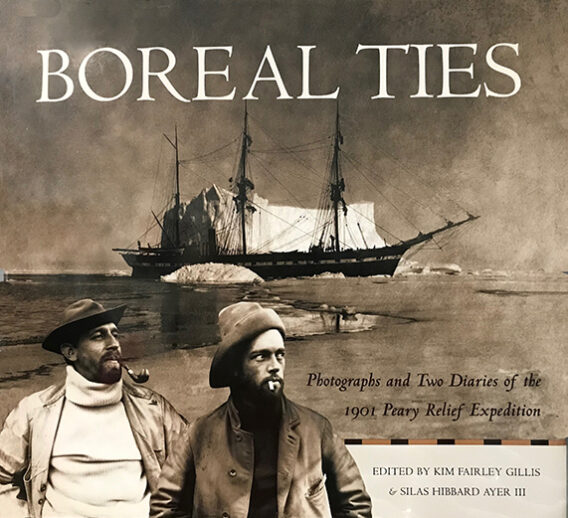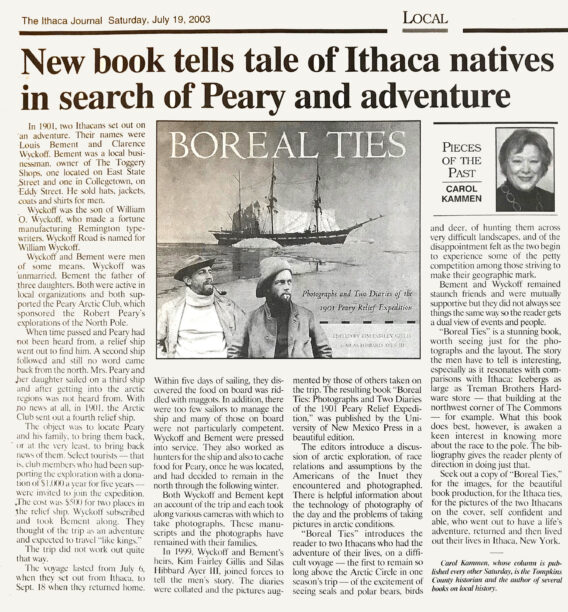
Boreal Ties
Photographs and Two Diaries of the 1901 Peary Relief Expedition
Boreal Ties is a compelling historical travelogue featuring annotated diaries and archival photographs from the 1901 Peary Relief Expedition to the Arctic. The book follows two amateur explorers, Clarence Wyckoff and Louis Bement, close friends from Ithaca, New York, who paid $500 each to join what we might now call an early version of adventure tourism.
Wyckoff and Bement set sail with dreams of hunting wild game, photographing Arctic landscapes, and escaping the pressures of their lives as American businessmen. The Arctic scenery did not disappoint—as shown in the rare, high-quality expedition photographs reproduced in this volume—but the voyage itself was far more dangerous than they expected.
They endured polar hardships, including maggoty food, head lice, and extreme cold, all intensified by the incompetence of the ship's crew. On more than one occasion, the ice floes and severe weather threatened their survival.
In addition to the expedition’s drama and the breathtaking photographic documentation of the Arctic, Boreal Ties also offers a unique anthropological lens: it provides a rare early record of American explorers’ encounters with Inuit communities, identifying many individuals by name and capturing a moment in time during a pivotal period of North Pole exploration.
To order:
The Making of Boreal Ties
The Making of Boreal Ties
"I don’t know what to do with these."
That’s what my great aunt Betty said as she handed me a rare 1901 photo album that had belonged to her father, Clarence Wyckoff, one of the participants in the Peary Relief Expedition. As she flipped through the pages, she pointed out crew members and several of the most famous Arctic explorers—including Robert Peary, Dr. Frederick Cook, and Matthew Henson—standing together on the decks of the Windward and Erik.
The album contained breathtaking images of Arctic exploration, including icebergs, Inuit communities, and the rugged landscapes of northern Greenland’s Thule region. It was a rare visual record of a historic polar expedition, with a surprising level of intimacy and detail.
At the time, I was completing my MFA at the University of Michigan, where I had spent most of my program creating large-scale collages based on Arctic exploration history. But what I discovered was unexpected: viewers were more captivated by the narratives behind the photographs than the artwork itself.
They wanted to know why these famed explorers, seemingly close friends in my great-grandfather’s photographs, had become bitter rivals just eight years later. That curiosity—and the visual and historical power of the photographs themselves—inspired the creation of Boreal Ties: Photographs and Two Diaries of the 1901 Peary Relief Expedition, a historical nonfiction book that bridges visual storytelling, memoir, and polar history.

A Little of the History
In 1909, after returning from placing an American flag at the North Pole with Matthew Henson, Robert Peary received shocking news: Dr. Frederick Cook claimed to have reached the North Pole a full year earlier, in 1908.
For Peary—who had spent his entire career focused on achieving this singular goal—the announcement was devastating. He and his supporters refused to believe that anyone else had arrived at the Pole before him. In response, they launched a nationwide campaign to discredit Dr. Cook, igniting one of the most infamous disputes in polar exploration history.
The result was a bitter rivalry that divided the public and scientific community, triggering a controversy over who truly discovered the North Pole—a debate that continues to this day.
Researching and Writing Boreal Ties
Since my great aunt Betty told me that her father, Clarence Wyckoff, always believed Dr. Frederick Cook and doubted Robert Peary’s claim to the North Pole, I set out to write a book about the 1901 Peary Relief Expedition after completing my graduate degree.
Carrying the original Arctic expedition photo album, I visited major archival institutions including the National Archives, the Prints and Photographs Reading Room at the Library of Congress, Cornell University Library, the Byrd Polar and Climate Research Center, and the George Eastman House International Museum of Photography and Film. These visits were crucial in identifying and verifying many of the historic Arctic photographs from the expedition.
After identifying most of the images, I transcribed my great-grandfather’s expedition diary. Recognizing their reputation for producing beautifully designed books in historical nonfiction and exploration narratives, I submitted a book proposal to the University of New Mexico Press, which accepted the project for publication.
I continued poring over my notes, hoping to find other rare Arctic images, especially those taken by the other men on the 1901 expedition. During this process, I came across the name Silas Ayer, whom Betty had suggested I contact.
“He’s the grandson of Uncle Louie,” she said—referring to Louis Bement, Clarence Wyckoff’s close friend and fellow traveler.
Meeting Silas Ayer
I tracked down Silas Ayer in Ellicott City, Maryland, and we arranged to meet at the National Archives. There, we compared his grandfather Louis Bement’s Arctic photo album to Wyckoff’s. Many of the expedition photographs were captured seconds apart from nearly identical angles, offering an extraordinary visual record of the journey from two perspectives.
Silas generously agreed to contribute his photographs and personal diaries to the project. With his support and feedback, I compiled the strongest images from both collections and wrote an introduction. Thanks to the expert editorial and design team at the University of New Mexico Press, the result was the publication of Boreal Ties: Photographs and Two Diaries of the 1901 Peary Relief Expedition—a unique blend of archival photography, memoir, and Arctic exploration history.


This photograph was taken following one of our talks.
"Historians are lucky to have Wyckoff and Bement’s rare and extraordinary record of their 1901 Arctic voyage, and as a novelist, I absolutely cherish my copy of Boreal Ties. The businessmen were not only in the right place in the right time, they were paying attention. To take such photographs, they clearly put themselves on the scene, front and central, entering into a landscape and into the lives of people they depicted."
—Katherine Kirkpatrick, Author of The Snow Baby: The Arctic Childhood of Admiral Robert E. Peary's Daring Daughter and Between Two Worlds.
